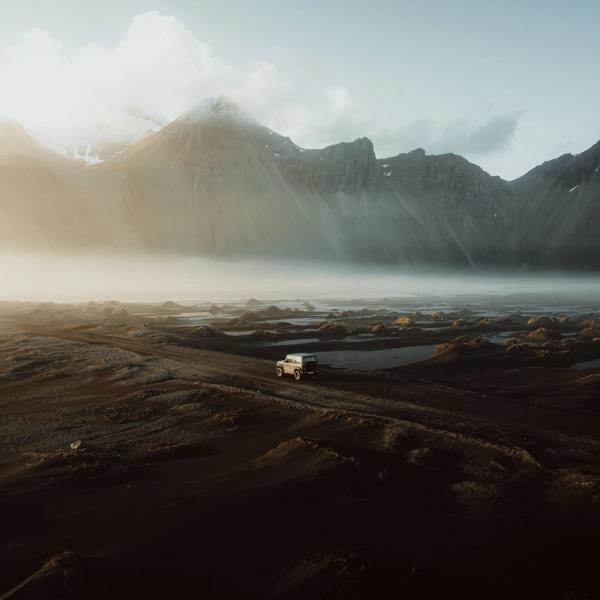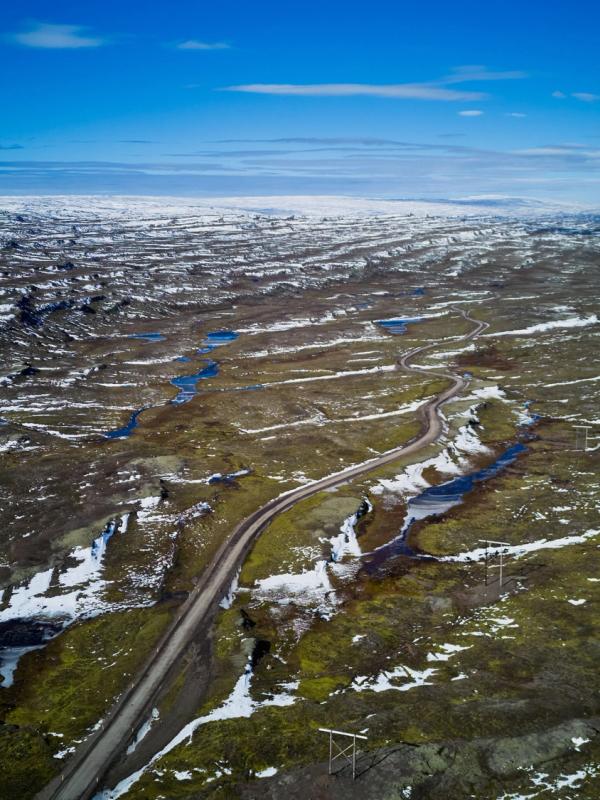
Ultimate Guide to the Highlands of Iceland
In Iceland, nature shows many faces in the diverse landscapes that can be found here. There is an almost endless list of natural wonders that can be visited in the country, and some of them are famous all over the world. However, some parts are not so well known, but where nature's raw power and beauty are on full display. Welcome to the Icelandic Highlands, a vast and uninhabited region in the heart of the island. This remote and difficult-to-access area has some of the best things to see and do in Iceland. Come with us to discover them.
Key Takeaways
- The Highlands are located in the center of Iceland, and are a huge extension of land.
- This area is uninhabited and experiences some of the harshest climate in the country.
- The Highlands are only accessible in the summer months, and the roads in the region are closed the rest of the year.
What are the Highlands?
The Icelandic Highlands are the central part of the island’s interior. It’s an elevated plateau with an average altitude of 400–500 meters (1,300–1,600 feet) above sea level. That doesn’t mean that it’s flat. Here, you can find some of the highest peaks in the country, as well as volcanic deserts, massive glaciers, beautiful valleys, and several geothermal areas. Here, the forces of nature have sculpted a dramatic terrain that sometimes seems like a different planet. There are no towns or cities here, and nature has been untouched by human development. It’s one of Europe's largest uninhabited areas.
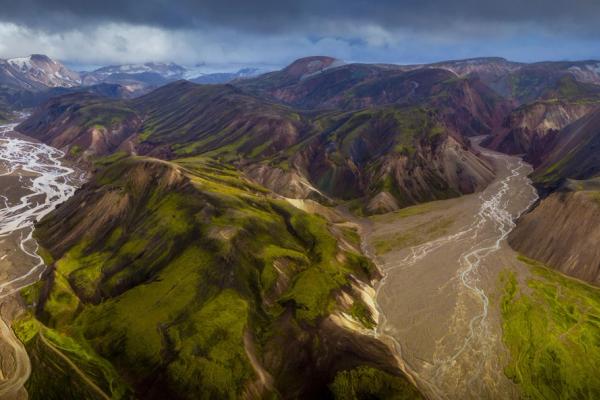
Where are the Highlands and How to Get There?
This area covers central Iceland, and stretches for approximately 40,000 square kilometers (15,444 square miles), around 40% of the whole country’s landmass. Despite its location in the heart of the island, it’s quite tricky to get there. The roads leading to the Highlands -the infamous F-roads, which we’ll explain later- are only open during the summer months. The rest of the year, the weather makes them impassable.
For this reason, getting to the Highlands demands careful planning. The roads are unpaved, uneven, and sometimes have river crossings. A 4x4 vehicle is necessary to navigate the F-roads, as conventional vehicles can’t cope with the conditions. There is no public transport to the Highlands. Always check the road conditions before heading out, as the weather can greatly impact them.
If you’re coming from Reykjavik, there are two main routes you can take, accessing the Highlands from the south. For the first one, take Route 1 (Ring Road) heading north and turn to Route 36 after Mosfellsbær. Continue on it past Þingvellir National Park, then Route 365 and Route 37 until you get to Gullfoss. Then, the F35 begins, going to the Highlands, to areas like Hveravellir and Kerlingarfjöll.
To reach Landmannalaugar, one of the most popular places in the Highlands, take Route 1, heading east until you get to the town of Hella. From there, take Route 26 north and then F208.
What to See and Do in the Highlands
Comprising 40% of the country's landmass, the Highlands are home to some of the most impressive sights in the country. Plus, it's a hikers' paradise.
Landmannalaugar
This is one of the most popular and easiest-to-access areas in the Highlands. It’s known for its colorful rhyolite mountains with shades of reds, oranges, and greens. There are several trails to explore the area. And, after a day of hiking, there’s nothing better than relaxing in the natural geothermal hot springs of Landmannalaugar.
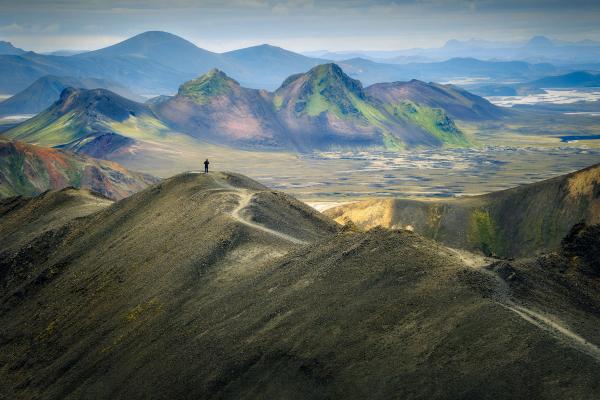
Þórsmörk (Thorsmork)
Named after the Norse god Thor, Þórsmörk is a green valley surrounded by mountains and glaciers. It's a hiker's paradise, with trails going through birch forests, over rivers, and up to panoramic viewpoints.
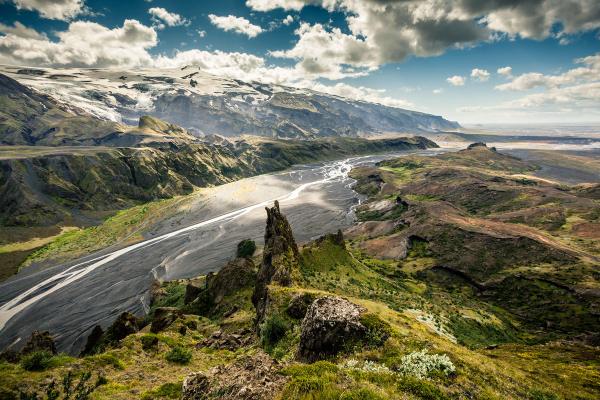
Laugavegur Trail
The Laugavegur Trail is one of the best hiking trails in Iceland. It has a length of 55 kilometers (34 miles) and connects Landmannalaugar and Þórsmörk. It takes three or four days to complete, depending on the pace and fitness level. During the route, you’ll pass through colorful mountains, volcanic deserts, hot springs, and beautiful valleys. There are mountain huts and campsites along the route where you can spend the night.
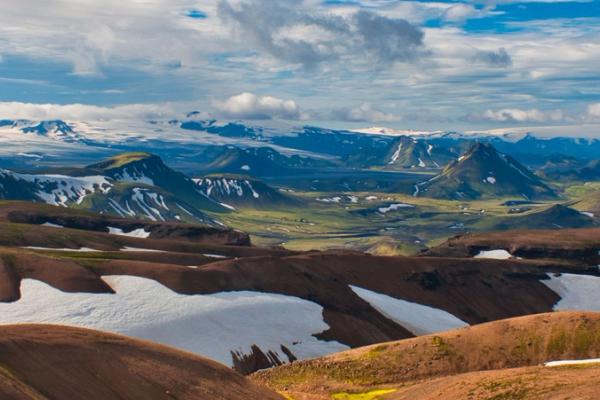
Hveravellir
Situated between the Langjökull and Hofsjökull glaciers, Hveravellir is a geothermal area with steaming fumaroles, bubbling hot springs, and mineral deposits. It's an active geothermal hotspot, and here, visitors can witness the Earth's geothermal energy up close.
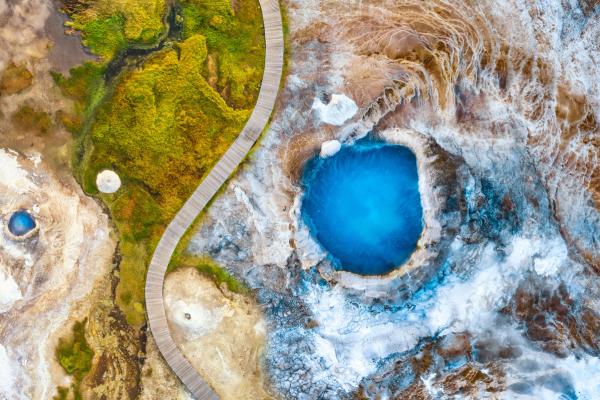
Mælifell Mountain
Mælifell is one of the most surreal sights in the Highlands. It’s a cone-shaped symmetrical volcano covered in green moss. The color of the mountain's surface creates an amazing contrast with the surrounding black lava fields. It’s not an easy journey to get there, with river crossings along the way. But if you make it, you’ll be rewarded with views over one of the most breathtaking landscapes in all of Iceland.

Hekla
Known as the "Gateway to Hell" in medieval times, Hekla is one of Iceland’s most active volcanoes. It has erupted more than 20 times since the 9th century, with its last eruption in 2000. The volcano is about 1,500 meters (4,921 feet) high and can be hiked when conditions are safe. The climb takes around 4 hours to reach the summit, and it’s not suitable for beginners. But once you get there, you’ll get panoramic views over the Highlands. It’s important to always check volcanic activity updates before planning a hike, as Hekla is unpredictable.
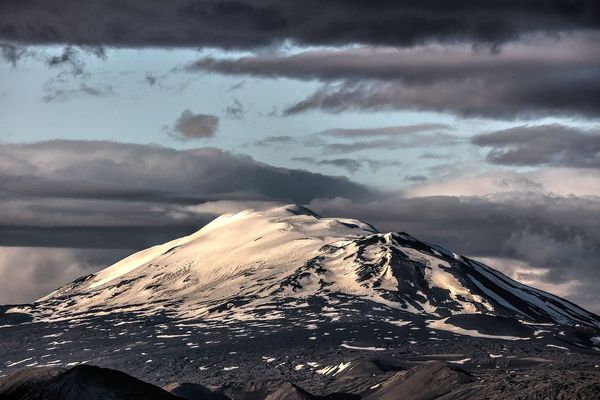
Laki Craters
The Laki Craters (Lakagígar) are the result of one of the largest volcanic eruptions in recorded history. Between 1783 and 1784, an eruption spews lava over a large area, leading to catastrophic climate effects. Today, the area is a beautiful landscape of 130 craters stretching over 27 kilometers (17 miles).
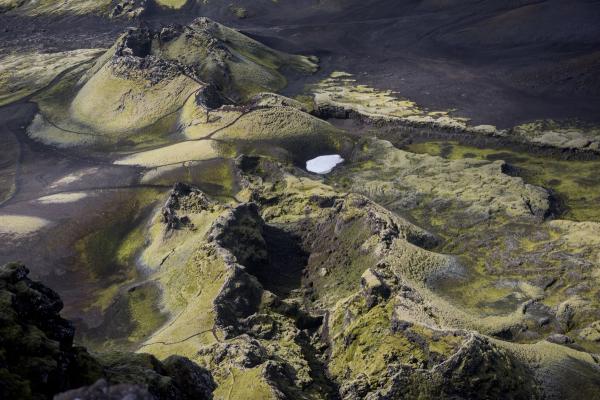
Best Time to Go
The weather in the Highlands is harsh for most of the year, which means accessibility is limited to the summer months, typically from June to September. Here's a breakdown of what to expect during these months:
- June: Early in the month, some F-Roads may still be closed due to lingering snow. By mid to late June, most routes are open. The long daylight hours, with almost 24 hours of natural light by the end of the month, allow plenty of time to explore.
- July: This is the best time to travel to the Highlands. All roads are generally open, and the weather is relatively mild, with temperatures ranging from 10°C to 15°C (50°F to 59°F). The flora is in full bloom, and it's an excellent month for hiking and photography.
- August: The conditions are still optimal, but towards the end of the month, temperatures begin to drop, and there are more chances of rain. The days get shorter by the week, but there’s still time to explore.
The Highlands are inaccessible outside these months due to snow, ice, and extreme weather conditions. Before planning your trip, always consult the Icelandic Road and Coastal Administration for up-to-date information.
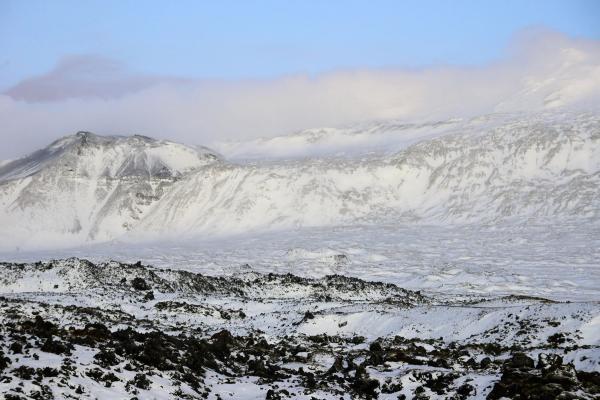
The F-Roads
As mentioned before, the roads leading to the Highlands are called F-roads. The "F" stands for "Fjall," the Icelandic word for mountain. The routes here are named F and then a number (like F208), so if you see a road with a name of this kind, that means it’s a mountain road. These roads are unpaved and can be challenging. These are some of the things that many F-roads have in common:
- Gravel and Loose Surfaces: The terrain is uneven and requires careful driving. The wheels can project small stones, so keep a safe distance from other cars to avoid damaging the paint and windows.
- River Crossings: Many F-Roads lack bridges over rivers, so you’ll need to cross them as they are. River depths can change, so always check before crossing and proceed cautiously.
- Steep Parts: The roads go through mountainous areas, and some areas have sharp ascents and descents.
Given these conditions, driving on F-Roads requires a powerful 4x4 vehicle. It’s also good to have some experience with off-road driving. In summer, these roads are generally open, but the weather changes drastically and quickly in Iceland, so some roads can suddenly open or close.
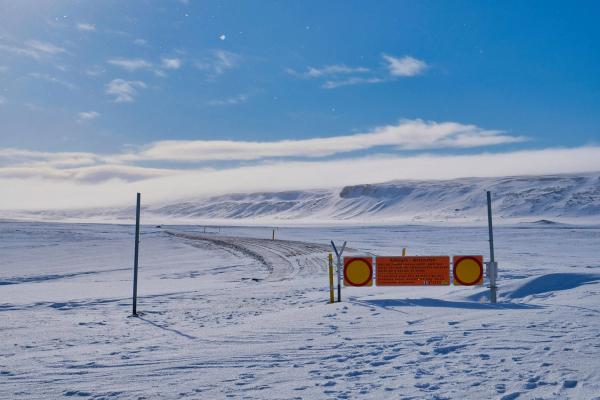
Where to Stay in the Highlands
The Highlands are remote, so traditional hotels are not available. However, huts, campsites, and a few remote lodges are still options for accommodation.
Mountain Huts
Operated by Ferðafélag Íslands (The Icelandic Touring Association, FÍ), these basic but comfortable huts offer shelter for hikers and adventurers. They usually include bunk beds, a communal kitchen, and shared bathrooms. They can be found primarily in Landmannalaugar and along the Laugavegur Trail. It’s highly recommended that you book in advance. As the Highlands are only accessible in summer and there are not many options, they can fill up rather quickly.
Campsites
There are several places in the Highlands where you can set up your tent. All the zones in the Laugavegur Trail with mountain huts have a camping area, giving access to basic facilities. Other campsites in the Highlands are:
- Landmannalaugar Campsite: A stunning setting near the hot springs.
- Hveravellir Campsite: Right next to a geothermal hot spring.
- Þórsmörk Campsite: Surrounded by mountains and glaciers.
Camping is the cheapest option, but be prepared for cold nights and unpredictable weather.
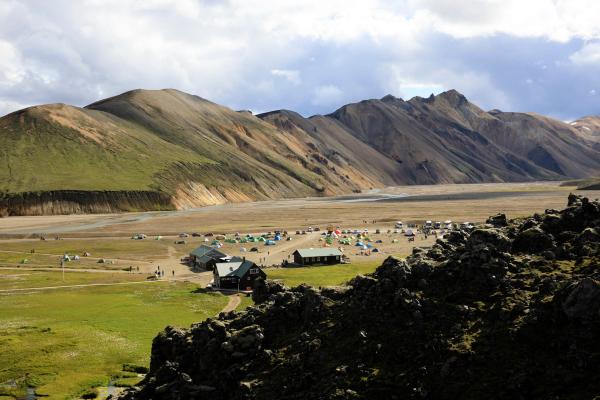
Highland Lodges & Guesthouses
For those who want more comfort, a few remote lodges offer heated cabins and full amenities:
- Highland Base Kerlingarfjöll – A newly developed hotel and hut system.
- Hrauneyjar Highland Center – A guesthouse near Landmannalaugar.
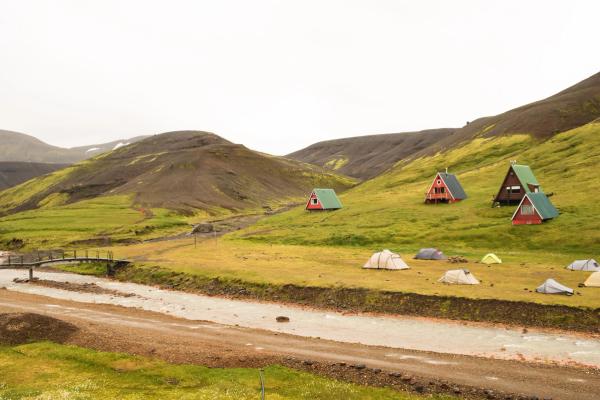
What to Wear for Traveling in the Highlands
The Highlands are one of the most unpredictable regions of Iceland. Even in summer, the weather can shift dramatically, bringing strong winds, low temperatures, or heavy rain within a matter of hours. Dressing correctly is essential for comfort and safety.
- Dress in layers. Temperatures in the Highlands can drop close to freezing, especially at night. Even if the air temperature isn’t too cold, the wind chill can make it feel much colder. If you dress in layers, you can adapt to the temperature changes. Use a warm base layer to retain body heat. Then, wear a medium layer made of fleece or wool. Cotton is not great because it absorbs sweat and stays wet. Finish off with an insulated jacket, which is necessary, especially in the early mornings and evenings.
- Waterproof Jacket and Pants. Rain is common in the Highlands, and the strong winds make staying dry even more important. A waterproof jacket and pants protect you from sudden showers and keep the wind from cutting through your layers. The best option is a breathable, waterproof material like Gore-Tex, which will keep you dry while allowing sweat to escape.
- Hiking Boots. The terrain in the Highlands is rough and uneven. A sturdy pair of hiking boots is essential for both safety and comfort. The boots should be waterproof, as it can rain often, and you may need to cross shallow streams. They should have good ankle support to deal with the rocky trails. Regular sneakers or casual hiking shoes are not recommended.
- Gloves, Hat, and Scarf. Even if you are only going to be able to go to the Highlands in summer, they can come in handy. In this remote region, there can be strong cold winds, even during the warmest months. Gloves, a hat, and a scarf can help you deal with the wind and sudden drops in temperature.
- Swimsuit and Towel. Even if the weather doesn’t look inviting, bringing a swimsuit and towel is a great idea. The Highlands have several natural hot springs, like the ones in Landmannalaugar and Hveravellir. These places provide a unique opportunity to enjoy a warm bath while surrounded by stunning landscapes. You’ll need a towel, too, and it's much better if it’s a quick-dry one. It won’t take up much space in your bag and dries faster than regular towels.
- Sunglasses and Sunscreen. The sun in this part of Iceland is stronger than you may think, so even on cloudy days, you should wear sunscreen. The sun's rays reflected off snow, water, or dark volcanic sand can harm your eyes and skin.
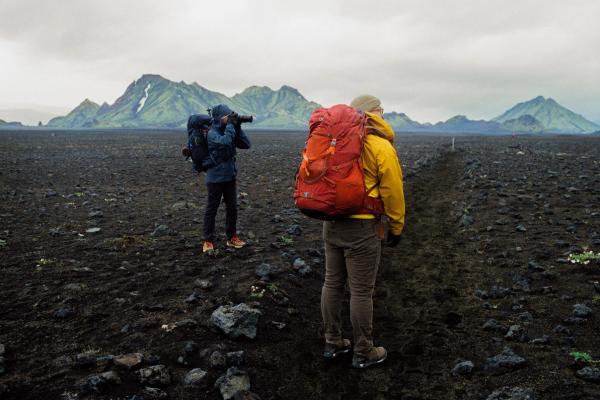
Travel Tips for the Highlands
Traveling in the Icelandic Highlands requires careful preparation. The region's remoteness means that there are no towns, barely any facilities, and unpredictable conditions.
Choose the right vehicle
Driving in the Highlands is completely different from driving on the usual paved roads that can be found in other parts of Iceland. As we have mentioned before, a 4x4 vehicle is mandatory for going on the F-roads, which are unpaved and rough. Many routes have loose gravel, large rocks, and steep inclines that a regular car cannot handle. When renting a vehicle, choose a high-clearance car to ensure the bottom doesn’t scratch on the rough roads. Driving a regular car on F-roads is not only dangerous but also illegal, and there could be fines for doing so.
Check Road and Weather Conditions
The weather in the Highlands can change within minutes, bringing rain, strong winds, or sudden cold spells. Before heading out, always check road conditions to ensure your route is open and safe. The weather can have a huge impact on the roads, so it’s also advisable to check the local forecast to avoid unpleasant surprises.
Prepare for River Crossings
Many F-roads in the Highlands, such as F88, F210, and F208, require crossing rivers, which can be extremely dangerous if not done correctly. The depth of the water can change depending on rainfall of previous hours or ice melt. Before crossing a river, stop and check the depth. If the water is moving too fast or is deeper than expected, do not cross. The safest way to go through is to drive slowly and steadily. If you are still not sure, wait for another car to cross to see how it goes. If not, it’s better to turn around than to have a bad experience.
Pack Extra Supplies
There are no supermarkets, shops, restaurants, or gas stations in the Highlands. Therefore, you must bring everything you need. Make sure you have enough food, drinking water, and emergency supplies for your entire trip. As there are no gas stations, fill up your fuel tank before getting into the Highlands. Running out of gas in the middle of nowhere is not only unpleasant but dangerous, and you can end up stranded for hours.
No Cell Phone Service
There’s very limited cell phone network coverage in the Highlands, and there are areas where there’s no reception at all. Google Maps can be a reliable ally, but relying only on it for navigation is a mistake, as you won’t have access to real-time directions. Instead, download offline maps through Google Maps, Maps.me, or Gaia GPS before your trip. If you’re planning a long journey into remote areas, it could be a good idea to bring a satellite phone. These devices can send emergency signals even when no phone service is available.
Respect the Environment
The Highlands are one of the most untouched wilderness areas in the world, and it is every traveler’s responsibility to protect them. Off-road driving is illegal and can cause severe damage to the delicate ecosystems that can be found here. Always stick to designated roads and trails, even if a path looks tempting. Additionally, pack out all your trash and avoid disturbing wildlife. Icelanders take pride in their natural environment, and they expect you to help preserve it.
Conclusion
The Icelandic Highlands have some of the most breathtaking and wild landscapes in the world. This remote and isolated region has impressive mountains, volcanic craters and deserts, waterfalls, and geothermal areas. It’s a dream for those looking for adventure. However, traveling to this part of the country requires careful planning, as the conditions there are special. The weather can be harsh, the roads are challenging, and there are chances to get there only in the summer months.
But if you’re looking for an unforgettable journey, one that takes you far beyond the usual tourist routes, the Highlands are waiting. Prepare well, respect the land, and embrace this untouched and wild corner of the world.

